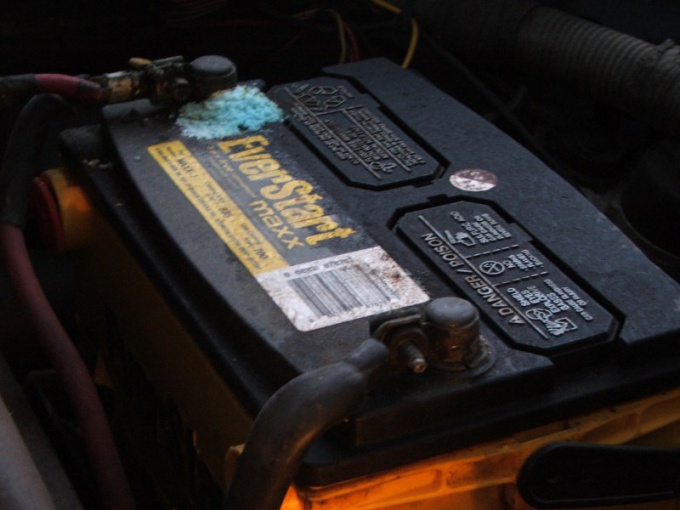You will need
- - AKB;
- charging-starting device;
- - wrenches or sockets (10mm for the battery terminal, the other dimensions — for fixing battery);
- - a metal file or sandpaper, and a voltmeter or tester would be an advantage;
- - served for battery may need a hydrometer and distilled water.
Instruction
1
Turn the ignition off and disconnect all electrical equipment. With the help of wrench or sockets 10mm loosen the negative first, then positive terminal on the battery electrode.
2
Depending on the car model the battery can be fixed on top, bottom, or not attached at all. Identifying the type of fastening of the battery, loosen the bolts holding the mounting bracket. Loosen and remove the battery. Carry it carefully, without turning, to prevent leakage of electrolyte.
3
Select a suitable location for charging the battery. Charger (memory) or battery must be on level solid surface. It is desirable that the room was ventilated and inaccessible to children. Charging should occur away from open flame. Close rechargeable battery no Smoking, and no spark. Wipe the battery clean of dirt. Inspect the lead electrodes in the presence of oxidation gently clean them with a file or sandpaper until the surface is shiny and bright for best conductivity.
4
If the battery is serviceable, remove the bar from the top and carefully remove the six plugs underneath. Measure the electrolyte level. Add distilled water to the desired level (1-1,5 cm above the lead plates). If the charger instruction throughout follow its instructions. Connect the terminals of the charger to the electrodes of the battery, strictly observing polarity. Depending on the memory model you may need to set the voltage toggle switch in the on position 12V and 24V, in accordance with the battery voltage.
5
Turn on plug the device into the socket. If there is a rheostat to vary the power current, install it in such a position that the ammeter showed a current equal to one tenth of battery capacity (e.g., for battery of the car VAZ 55A/h need charge current of 5.5 A). As the battery is charging, the current will weaken. Try to check this figure every two hours and, if necessary, increase the current using the rheostat. Model memory with automatic switch will stop charging when the desired voltage.
6
To determine the degree of battery charge, you can use the following methods. Measure the voltage with a voltmeter (tester). The accepted battery you can measure the electrolyte density with a hydrometer. Grounds for termination of the charging can be 12-16 volts voltage or electrolyte density of 1.25-1.3 kg/l. With open jams of the sections of the battery can start the release of gas and "boiling" (a characteristic gurgling) of the electrolyte is also a signal of readiness of the battery.
7
When charging ends, unplug the charger, remove the terminals from the battery electrode, assemble its parts and, if necessary, reinstall.
Note
The drop of battery voltage can be caused by prolonged inactivity of the car, low air temperature, age of the battery, a ground of the electric circuit of the car, lack of electrolytes and other reasons.
When removing the terminals from the electrode long key please use caution when dismantling one terminal to touch the other, a short circuit occurs.
Electrolyte — a mixture of sulfuric acid and water is particularly aggressive and toxic liquid. Avoid spilling electrolyte on the skin. In case of contact with eyes immediately rinse thoroughly with water.
When removing the terminals from the electrode long key please use caution when dismantling one terminal to touch the other, a short circuit occurs.
Electrolyte — a mixture of sulfuric acid and water is particularly aggressive and toxic liquid. Avoid spilling electrolyte on the skin. In case of contact with eyes immediately rinse thoroughly with water.
Useful advice
If the polarity symbols AKB indistinguishable (dirty wiped) note that the positive electrode always more negative in a diameter of about 2 mm.
You can conduct a "preventive" recharging the car battery once a year (e.g. in early winter when the first frost) on low current — 0.1, 0,025-0,05 the capacity of the battery.
You can conduct a "preventive" recharging the car battery once a year (e.g. in early winter when the first frost) on low current — 0.1, 0,025-0,05 the capacity of the battery.
